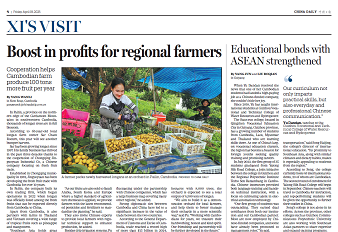Mount Foding

A turbulent stream runs down Mount Foding. [Photo provided to chinadaily.com.cn]
Mount Foding Provincial Nature Reserve lies in the south end of Ganxi village in Shiqian county Tongren city, Guizhou province. It covers an area of 1,263.45 square kilometers and its highest peak, Mount Foding, is 1,869.3 meters. The reserve is 30 kilometers away from Shiqian town.
Mount Foding is the sacred center for Buddhism in eastern Guizhou. Like Mount Fanjing, it is also a well-preserved subtropical evergreen broad-leaf forest region in northeastern Guizhou. Mount Foding is moist and humid with plentiful rain fall. It has an annual average precipitation of 1,100 to 1,350 mm.
The lofty mountain, complex terrain and well-preserved forest vegetation provide a perfect environment for forest animals. Vertebrates and insects in 119 families and 417 species have been identified and named, and 31 species are classified as national key protected animals.
Mount Foding Nature Reserve has abundant tourism resources, namely forests, mountains, valleys, religious culture and outdoor sports such as mountain-climbing. The reserve's rich flora and fauna also make it an ideal place for scientific research.
Mount Foding is home to approximately 500 Davidia involucrate, which is described as a living tree fossil and is listed as a first class national protected plant.
The “King of Chinese fir” grows at Sifangyin on Mount Foding at a height of 1,300 meters. The tree is tall and straight with dense, waterproof branches and leaves. It produces more than 50 kilograms of cones every year. The tree's growth rings reveal an environment that has been continually changing throughout history. These growth rings are of great scientific value for paleoclimatology, paleogeology, and paleovegetation.
All rights Reserved. 京ICP备13028878号-8







 Overview
Overview Guiyang
Guiyang Guian New Area
Guian New Area Liupanshui
Liupanshui Anshun
Anshun Qianxinan
Qianxinan Qiandongnan
Qiandongnan Qiannan
Qiannan Zunyi
Zunyi Tongren
Tongren Bijie
Bijie Guizhou commits to culture preservation and rural vitalization
Guizhou commits to culture preservation and rural vitalization Guizhou voice at 2025 national two sessions
Guizhou voice at 2025 national two sessions Meet the 'genius moms' at Shenzhen cultural fair
Meet the 'genius moms' at Shenzhen cultural fair 

